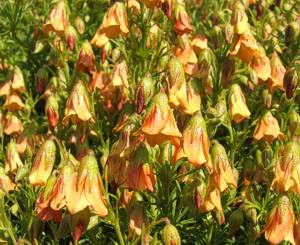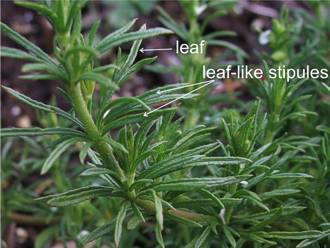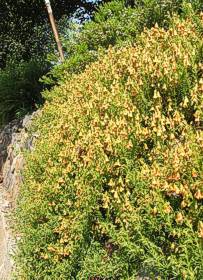Hermannia pinnata
Hermannia pinnata L.
Family: Malvaceae
Common names: orange hermannia/doll's rose (Eng.), kwasblaar kruip poprosie (Afr.)
Introduction
Hermannia pinnata is a decorative groundcover, covered in masses of honey-scented pale orange bells in early summer, and ideal for hanging baskets, retaining walls and rockeries.

Description
Description
Hermannia pinnata is a fast-growing, mat-forming shrublet to 150 mm, with creeping stems. Leaves are narrow, linear to 3-lobed and the stipules are also divided into 2 or 3 narrow leaf-like lobes making the leaves appear to be whorled (arranged in a circle at one node). The flowers are pale orange nodding bells, honey-scented and produced in masses during spring to early summer (Sept-Oct). The flowers are dark reddish-orange in bud and as they open, that darker reddish colour fades to pale orange with dark reddish veins.

Conservation Status
Status
Not threatened.
Distribution and habitat
Distribution description
Hermannia pinnata occurs on sandy coastal flats and dunes along the west coast of the Western Cape, from Velddrif to the Cape Peninsula, and was once common in the Milnerton area.
Derivation of name and historical aspects
History
The genus Hermannia is named after Paul Hermann (1640-95), born in Halle, Saxony (Germany), for a long time a physician in Ceylon (Sri Lanka), he spent some time at the Cape where he collected many plants, returned to Europe and became Professor of botany at Leyden in Holland. The species name pinnata is from the Latin pinnatus meaning feathered or winged, and refers to the pinnately lobed leaves. The common name Doll's Rose (Poprosie in Afrikaans) for the genus refers to the way the petals of some species are twisted in such a way that the flower resembles a miniature rose.
Hermannia pinnata was named by Linnaeus in his Species Plantarum of 1753 but he later moved it into the genus Mahernia in his Mantissa Plantarum in 1767. Bergius described a different specimen of the same species as Hermannia verticillata in 1767, and in the same year, Linnaeus described that specimen as Mahernia verticillata. In 1895 K. Schumann put the genus Mahernia into synonymy under Hermannia, placing Mahernia as a section of Hermannia, and raising it to subgeneric rank in 1900. It was only much later, his findings published in 1974, that Bernard De Winter tracked down Linnaeus's original type specimen for H. pinnata and confirmed that they are one and the same species. The earlier name H. pinnata was conserved and M. verticillata reduced to a synonym.
Hermannia pinnata was collected at the Cape by Francis Masson who introduced it to cultivation in Europe in 1774. It was illustrated by William Curtis in 1794 under the name Mahernia pinnata or Winged Mahernia.
Hermannia belongs in the Malvaceae (hibiscus, mallow and cotton family), and was previously placed in the Sterculiaceae (sterculia family). Hermannia is a genus of ± 180 species that occur mainly in southern Africa: ± 162 species widespread in southern Africa, 11 species in tropical Africa with ± 30 southern Africa species that also occur in tropical Africa, 3 American species and 1 or more Australian species.
Ecology
Ecology
Hermannia pinnata flowers are produced in abundance and are worked by bees.
Uses
Use
Although this species is not known to be used medicinally, many other hermannias are. The leaves of some species, e.g. H. multiflora, H. linearifolia and H. pulchella, known as pleisterbos (plaster bush), are rubbed together to form a sticky mass, which is used as a healing plaster for sores and cuts. H. hyssopifolia and H. althaeifolia are known as pokkiesblom and were used in the late 1700s to make a medicinal tea used to treat syphilis. H. geniculata is known as asmabossie as the roots were used in the treatment of respiratory illness, particularly asthma. Some, e.g. H cuneifolia, H. hyssopifolia, are called geneesbossie (healing bush) and their leaves were used in the treatment of sores or were taken internally as a blood purifier.
Growing Hermannia pinnata
Grow
Hermannia pinnata is a quick-growing evergreen, mat-forming groundcover. It is best in a sunny position in sandy or well-drained soil, or on a slope. It is water-wise and wind-tolerant, well-suited to coastal gardens, and needs protection from frost.
Hermannia pinnata can be used in the garden as an edging plant, a groundcover in a sunny spot or on a sunny slope, in the rockery, on terraced and retaining walls, in containers or hanging baskets.
Hermannia pinnata can be propagated by seed or cuttings. Sow seed in late summer to autumn or spring to early summer. Use well-drained sowing medium and cover lightly. Seedlings should emerge in about 10 days and can be pricked out when they are large enough to handle.
Softwood cuttings ( ± 100 mm long) taken from actively growing plants should be taken in spring to early summer, treated with rooting hormone and placed in a propagation unit with bottom heat of 25° C (80° F) and intermittent mist. Use a well-drained, well-aerated rooting medium, e.g. 50% fine milled pine bark and 50 % polystyrene granules. Rooting should occur within 4 weeks with ± 90% success rate. The cuttings should be weaned for 3 weeks. At Kirstenbosch, the cuttings are fed with a seaweed-based fertiliser during the weaning period.
References
- Goldblatt, P. & Manning, J. 2000. Cape Plants, A Conspectus of the Cape Flora of South Africa. Strelitzia 9. National Botanical Institute, Pretoria & Missouri Botanical Garden Press, Missouri
- Manning, J., Goldblatt, P. 1996. West Coast, South African Wild Flower Guide 7. Botanical Society of South Africa, Cape Town
- Manning, J. 2007. Field Guide to Fynbos. Struik Publishers, Cape Town.
- Trinder-Smith, T. 2006. Wild Flowers of the Table Mountain National Park. South African Flower Guide 12. Botanical Society of South Africa
- Curtis, W. 1794. The Botanical Magazine; Or, Flower-garden Displayed: In which the Most Ornamental Foreign Plants, Cultivated in the Open Ground, the Green-house, and the Stove, are Accurately Represented in Their Natural Colours. digitized by Google
- De Winter, B. 1974. The identity of some species of Hermannia represented in the Linnaean, Thunberg, Bergius and Cavanilles Herbaria. Bothalia 11(3):263-264.
- Verdoorn, I.C. 1980. Revision of Hermannia subgenus Hermannia in southern Africa. Bothalia 13,1 & 2: 1-63.
- Leistner, O.A. (ed.). 2000. Seeds plants of southern Africa : families and genera. Strelitzia 10. National Botanical Institute, Pretoria.
- Smith, C.A. 1966. Common names of South African plants. Memoirs of the Botanical Survey of South Africa No. 35.
- Jackson, W.P.U. 1990. Origins and Meanings of Names of South African Plant Genera. U.C.T. Printing Dept., Cape Town.
- Willdenow, Karl Ludwig, translated from the German of Willdenow, D.C. 1811. The Principles of Botany, and of Vegetable Physiology. University Press for William Blackwood, London.
Credits
Alice Notten
Kirstenbosch National Botanical Garden
October 2008
Plant Attributes:
Plant Type: Ground Cover, Shrub
SA Distribution: Northern Cape, Western Cape
Soil type: Sandy
Flowering season: Spring, Early Summer
PH:
Flower colour: Orange
Aspect: Full Sun
Gardening skill: Easy
Special Features:
Horticultural zones











Rate this article
Article well written and informative
Rate this plant
Is this an interesting plant?
Login to add your Comment
Back to topNot registered yet? Click here to register.